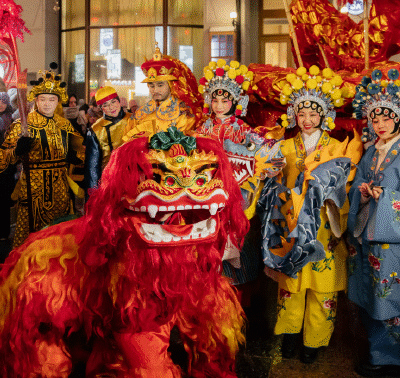The Chinese Zodiac (Shí’èr Shēngxiào) is far more than a simple set of animals representing years. It embodies a rich worldview, values, and cultural identity deeply woven into the fabric of Chinese civilization. From marking time to influencing relationships and festivals, the Zodiac has shaped the lives of generations. This article explores the Chinese Zodiac from historical, philosophical, artistic, and cultural perspectives.
1. The Basics of the Chinese Zodiac
The 12 Zodiac Animals
| Order | Chinese | Pinyin | English | Earthly Branch | Element | Symbolism |
|---|---|---|---|---|---|---|
| 1 | 鼠 | shǔ | Rat | Zi (子) | Water | Wisdom, agility |
| 2 | 牛 | niú | Ox | Chou (丑) | Earth | Steadfastness, diligence |
| 3 | 虎 | hǔ | Tiger | Yin (寅) | Wood | Courage, authority |
| 4 | 兔 | tù | Rabbit | Mao (卯) | Wood | Gentleness, kindness |
| 5 | 龙 | lóng | Dragon | Chen (辰) | Earth | Nobility, success |
| 6 | 蛇 | shé | Snake | Si (巳) | Fire | Wisdom, mystery |
| 7 | 马 | mǎ | Horse | Wu (午) | Fire | Freedom, decisiveness |
| 8 | 羊 | yáng | Goat | Wei (未) | Earth | Gentleness, compassion |
| 9 | 猴 | hóu | Monkey | Shen (申) | Metal | Cleverness, humor |
| 10 | 鸡 | jī | Rooster | You (酉) | Metal | Punctuality, precision |
| 11 | 狗 | gǒu | Dog | Xu (戌) | Earth | Loyalty, justice |
| 12 | 猪 | zhū | Pig | Hai (亥) | Water | Generosity, honesty |
2. Origins: From Totems to Timekeeping
Mythology
Legend has it that the Jade Emperor summoned animals to compete for a place in the Zodiac. The clever rat rode on the ox’s back and jumped ahead to claim first place, while the mighty dragon paused to help others, placing fifth. These stories, though mythological, have left an enduring cultural legacy.
Historical Evidence
Archaeological findings reveal zodiac symbols dating back to the Warring States period (~3rd century BCE), with more formal mentions appearing in the Han Dynasty texts. The Zodiac combines with the Heavenly Stems and Earthly Branches system to create the 60-year sexagenary cycle, a unique Chinese timekeeping method.
3. Zodiac as a Philosophical System: Heaven, Earth, and Humanity
Each Zodiac sign corresponds with:
- Earthly Branches (Chinese time division system),
- Five Elements (Wood, Fire, Earth, Metal, Water),
- Yin-Yang polarity, and
- Two-hour time segments in the traditional Chinese day.
This complex system makes the Zodiac a comprehensive symbol of cosmic order, not just a calendar tool.
4. Modern Applications of the Chinese Zodiac
(1) Fortune-telling and Compatibility
The Zodiac plays a central role in Chinese astrology, influencing marriage compatibility, career choices, and auspicious dates. For example, dragons and roosters are considered compatible, while tigers and monkeys clash.
(2) Festivals and Cultural Arts
- During Chinese New Year, decorations featuring the year’s Zodiac animal are everywhere—from lanterns to red envelopes.
- Zodiac motifs appear extensively in traditional Chinese paintings, paper cuts, ceramics, and contemporary media.
(3) Branding and Popular Culture
Many companies and cities launch Zodiac-themed merchandise and campaigns yearly, including collectible stamps, jewelry, apparel, and toys, contributing to a growing cultural economy.
Suggested image:
Photos of Chinese New Year decorations featuring the current Zodiac animal in public spaces or markets.
5. Global Influence of the Chinese Zodiac
The Zodiac’s influence extends beyond China:
- East Asia: Countries like Japan, Korea, and Vietnam have adopted similar Zodiac systems.
- The West: Chinese Zodiac animals appear in Chinatown festivals, educational programs, and cultural exhibitions worldwide.
- United Nations: In 2021, China donated a set of Zodiac bronze sculptures to the UN headquarters, symbolizing global friendship.
6. Zodiac and Personal Identity
In China, asking “What’s your Zodiac sign?” is akin to asking about one’s personality or life traits, similar to Western astrology.
- People born in different Zodiac years often identify with common generational characteristics.
- Zodiac signs are used as conversational icebreakers and social identity markers.
7. Zodiac and Life Stages
| Life Stage | Zodiac-related Belief | Traditional Practices |
|---|---|---|
| Birth Year | “Ben Ming Nian” (本命年), considered unlucky | Wearing red clothes, red bracelets for protection |
| Adulthood | Important transitional periods | Worship of Tai Sui (God of Age) |
| Marriage & Family | Zodiac compatibility checked | Matchmaking based on Zodiac harmony |
Conclusion: The Zodiac as a “Language of Time”
The Chinese Zodiac is more than a collection of animals — it is a symbolic system integrating natural law, human relationships, and cosmic rhythm. It continues to inspire and unify millions worldwide, blending ancient wisdom with modern life.
Whether you are a cultural enthusiast or a curious traveler, exploring the Chinese Zodiac offers a unique window into the heart of Chinese civilization.


